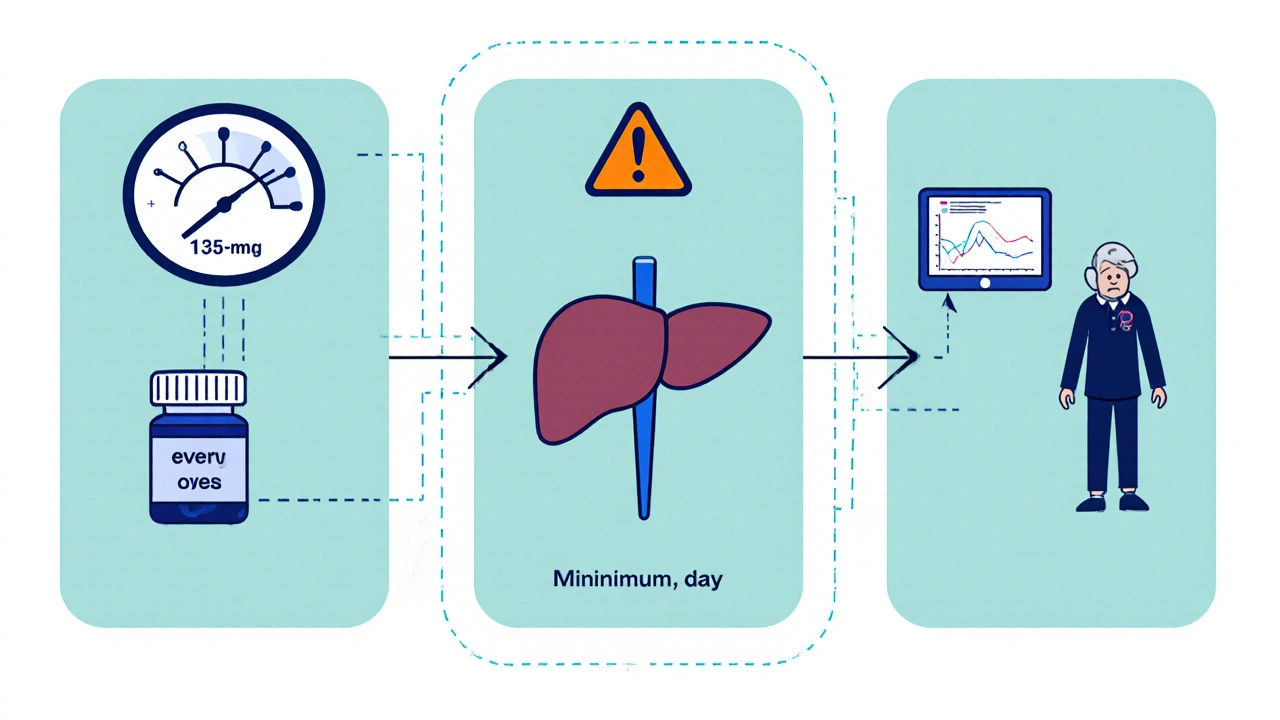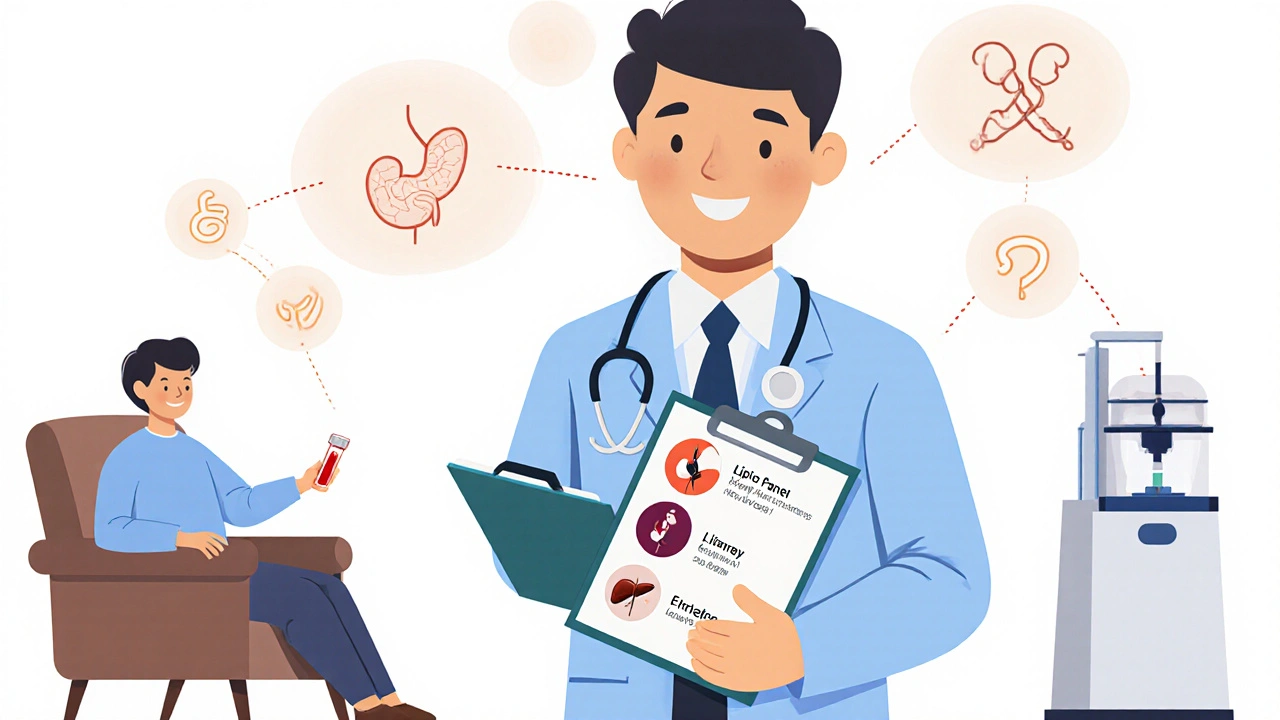Fenofibrate Dosage Calculator
Key Takeaways
- Fenofibrate is taken once daily with a full meal to boost absorption.
- Standard adult dose is 145mg (or 160mg extended‑release) for most patients.
- Kidney or liver impairment, age, and drug interactions often require dose adjustments.
- Monitor lipids, liver enzymes, and kidney function before and during therapy.
- Common side effects include mild GI upset and muscle aches; serious reactions are rare but need prompt attention.
When doctors prescribe Fenofibrate is a fibric acid derivative used to lower triglycerides and modestly raise HDL cholesterol. It works by activating PPARα (peroxisome proliferator‑activated receptor alpha, a nuclear receptor that regulates lipid metabolism). Understanding the right fenofibrate dosage and how to take it can make a big difference in controlling hyperlipidemia (elevated blood lipids that increase cardiovascular risk) without adding unnecessary side effects.
What Is Fenofibrate?
Fenofibrate belongs to the class of fibrates, which are especially good at reducing triglycerides (a type of fat in the blood that can contribute to plaque buildup). While statins (HMG‑CoA reductase inhibitors that primarily lower LDL cholesterol) remain the first‑line therapy for high LDL, many patients benefit from adding fenofibrate when triglycerides stay high despite statin use.
Why Dosage Matters
Because fenofibrate’s absorption is food‑dependent, the dose you take and when you take it affect how much drug actually reaches the bloodstream. Too low a dose might not lower triglycerides enough; too high a dose can increase the risk of liver enzyme spikes or muscle complaints, especially when combined with certain other lipid‑lowering drugs.
Standard Dosing Guidelines
- Adults without special concerns: 145mg immediate‑release tablet taken once daily with the largest meal of the day, or 160mg extended‑release capsule taken once daily with food.
- Patients with mild‑to‑moderate renal impairment (creatinine clearance 30‑60mL/min): Reduce the dose by 50% - typically 145mg every other day or a lower‑strength capsule if available.
- Severe renal impairment (creatinine clearance <30mL/min): Fenofibrate is generally avoided; alternative agents such as omega‑3 fatty acids or niacin may be safer.
- Elderly (≥75years): Start at the lowest dose and monitor liver function tests (LFTs) and creatine kinase (CK) closely.
The dose recommendations above follow the latest FDA labeling (2024 update) and align with major cardiology guidelines released in 2025.

Special Populations & Adjustments
Beyond kidney function, two other factors often dictate dose changes:
- Liver disease: Since fenofibrate is metabolized partially by the liver, patients with moderate to severe hepatic impairment should either avoid the drug or use the lowest possible dose under strict monitoring.
- Drug interactions: Certain medications inhibit CYP2C9 (a liver enzyme that metabolizes fenofibrate and many other drugs). Strong CYP2C9 inhibitors (e.g., fluconazole, amiodarone) can raise fenofibrate levels, so dose reduction or a switch to an alternative fibrate may be needed.
How to Take Fenofibrate Correctly
Getting the most out of fenofibrate is almost as simple as remembering these steps:
- Take the tablet or capsule with the largest meal of the day - a breakfast of eggs and toast works just as well as a dinner steak.
- Avoid crushing or chewing the tablet; the formulation is designed for gradual release.
- If you miss a dose, take it as soon as you remember, but only if it’s still within the same meal window. Skip it if the next meal is more than 6hours away.
- Do not switch between immediate‑release and extended‑release forms without doctor guidance; the dosing isn’t interchangeable.
- Store the medication at room temperature, away from moisture and heat.
Common Side Effects & What to Watch For
Most people experience mild gastrointestinal upset - think a bit of nausea or an occasional stomach rumble. Less common but important signals include:
- Elevated liver enzymes (ALT, AST) - labs should be checked before starting therapy and then every 6-12weeks.
- Muscle pain or weakness, especially if you’re also on a statin. Persistent muscle aches warrant a CK test.
- Gallstone formation - rare, but patients with a history of gallbladder disease should discuss alternatives.
If any of these symptoms become severe or are accompanied by jaundice, dark urine, or unexplained fatigue, contact your healthcare provider right away.

Interaction With Other Lipid‑Lowering Drugs
Fenofibrate is often paired with other agents to achieve a comprehensive lipid profile. Here’s a quick snapshot of the most common combos:
- Statins (e.g., atorvastatin, rosuvastatin): Generally safe, but monitor for increased muscle toxicity. The FDA recommends no more than a moderate‑intensity statin when combined with fenofibrate.
- Gemfibrozil: Do not combine - both are fibrates and together they can dramatically raise the risk of rhabdomyolysis.
- Niacin: Can be used together, but both increase flushing and may raise liver enzymes; dose titration is essential.
- Bile acid sequestrants (e.g., cholestyramine): Take fenofibrate at least 1hour before or 4hours after the sequestrant to avoid binding and loss of absorption.
Comparison Table: Fenofibrate vs. Other Lipid‑Lowering Agents
| Agent | Primary Mechanism | Typical Adult Dose | Main Lipid Target | Common Side Effects |
|---|---|---|---|---|
| Fenofibrate | PPARα activation | 145mg daily (IR) or 160mg daily (XR) | ↓ Triglycerides, ↑ HDL | GI upset, ↑ LFTs, muscle pain |
| Statins | HMG‑CoA reductase inhibition | 10‑80mg daily (depends on specific statin) | ↓ LDL‑C | Muscle aches, liver enzyme rise |
| Gemfibrozil | PPARα activation (similar to fenofibrate) | 600mg twice daily | ↓ Triglycerides | GI upset, gallstones, higher muscle toxicity when combined with statins |
| Niacin | Inhibits hepatic VLDL synthesis | 500‑2000mg daily divided | ↑ HDL, ↓ LDL & triglycerides | Flushing, hyperuricemia, liver toxicity |
Frequently Asked Questions
Can I take fenofibrate without a meal?
No. Food significantly boosts fenofibrate absorption; taking it on an empty stomach can reduce its effectiveness by up to 50%.
How often should I get blood tests while on fenofibrate?
Baseline liver enzymes, renal function, and lipid panel are checked before starting. Follow‑up labs are typically done at 6‑week intervals for the first 3months, then every 6‑12months if stable.
Is fenofibrate safe during pregnancy?
Fenofibrate is classified as Pregnancy Category C. It should only be used if the potential benefit outweighs the risk, and only under close medical supervision.
What should I do if I experience muscle pain while on fenofibrate and a statin?
Stop the medications and contact your doctor immediately. A CK test will determine if muscle injury is occurring, and the provider may adjust doses or switch agents.
Can I switch from immediate‑release to extended‑release fenofibrate?
You can, but the dosing isn’t a 1‑to‑1 swap. The extended‑release form usually requires a 160mg dose for comparable effect. Always make the change under physician guidance.
Understanding the right dose and how to take fenofibrate empowers you to keep triglycerides in check while minimizing unwanted effects. Stick to the meal‑timed schedule, keep an eye on labs, and talk openly with your clinician about any other meds you’re on. With that approach, fenofibrate can be a reliable part of a heart‑healthy plan.



Comments
Hey folks, remember that fenofibrate really works best when you take it with a big meal – think breakfast eggs and toast or a hearty dinner. This helps the drug get absorbed and keeps your triglycerides in check. If you ever miss a dose, just grab it with your next main meal rather than a snack.
Don't trust the glossy pamphlet the pharma giants hand you; they hide the fact that fenofibrate's absorption tricks are designed to keep you on pricey follow‑up visits. Every time you swallow it without a meal, they claim it's 'ineffective' just to push a newer version.
Another boring drug guide, same old boilerplate.
I hear the fatigue that comes from endless warnings, and it can feel overwhelming 😔. Yet the science behind fenofibrate’s meal‑timed dosing is rooted in how our bodies handle lipids, a reminder that even small routines can steer big health outcomes. Think of it as a rhythm your liver and gut have agreed upon, and honor that cadence.
Imagine your body as a symphony, each instrument playing its part; fenofibrate is just the conductor ensuring the low‑frequency triglycerides don’t drown out the melody of health. By pairing it with a proper meal, we give the conductor a clear score, and the whole ensemble performs harmoniously. Stay hopeful and keep the rhythm.
Because obviously we all love a drug that needs a steak dinner to work, right?
While some whisper about hidden agendas, the truth is simple: our own health should be the priority, not foreign pharma puppets pulling strings. Keep your focus on the basics-food, exercise, and the meds that actually help.
Let me tell you a story that starts in the kitchen, where the aroma of sizzling bacon meets the quiet hum of a refrigerator holding a bottle of fenofibrate. The moment you place that tablet on the countertop, you are already stepping into a dance that your body has choreographed long before modern medicine whispered its name. You may think it’s just another pill, but in reality it’s a key that unlocks the vault of lipid metabolism hidden deep within your cells. The way it demands a full‑size meal isn’t a marketing gimmick; it’s a biological imperative rooted in the very physics of solubility and enterohepatic circulation. Imagine the tablet as a shy actor, timid when alone, thriving only when the spotlight of dietary fat shines upon it. That spotlight comes from proteins, oils, and cholesterol that coax the drug into the lymphatic system, where it finally meets the bloodstream. Skipping the meal is like sending our shy actor onto the stage without a costume-awkward, unnoticed, and ineffective. Moreover, the timing of the dose can influence how the liver processes it, either smoothing out enzyme spikes or provoking them into a frenzy. When you align the pill with your biggest meal, you gift it the supportive environment it craves, much like giving a plant the perfect amount of sunlight and water. The science isn’t abstract; it’s engraved in the FDA’s labeling, reinforced by countless clinical trials that show better triglyceride reduction under fed conditions. Yet, the stories we hear on forums, in coffee shops, or whispered by the pharmacy clerk often overlook this nuance, reducing the drug to a mere bullet point in a spreadsheet. So, let’s honor the complexity: take the pill with eggs, toast, or a hearty salad, and watch how your numbers gradually descend like a sunset slipping behind a hill. Remember, this isn’t about blind obedience to a prescription; it’s about partnership with your own biology, a conversation where food and medicine speak the same language. In the end, the melodrama of health isn’t confined to headline‑grabbing side effects; it lives in the quiet decisions we make at breakfast. So, next time you reach for that capsule, pause, pour a glass of orange juice, and savor the meal that will make the medicine work its magic.
While your culinary metaphor is certainly entertaining 😊, the pharmacokinetic data actually show that the presence of dietary fat increases fenofibrate’s AUC by roughly 40‑50%. This isn’t just anecdotal; it’s been quantified in controlled crossover studies that specifically measured plasma concentrations with and without meals. So, the “magic” you describe is fundamentally a measurable increase in bioavailability, not mystical synergy.
Hey! Just a quick remindr to set an alarm for your dinner dose-missing it can mess up your lipid numbers.
Absolutely! That tiny alarm can become your personal guardian angel, swooping in just before the evening meal to ensure the fenofibrate gets its grand entrance. Your commitment to that simple cue turns a routine into a celebration of self‑care, and the results will echo in every lab report.
Listen up!!! The real story behind fenofibrat isn’t some sterile FDA brochure-it’s a battlefield where our nation’s health is fought!!! They want us to swallow pills on an empty stomach while they sell us “miracle” supplements that do nothing!!! Only by taking the drug with a hearty American meal do we reclaim our sovereignty over cholesterol!!! Don’t be fooled by the overseas labs pushing “alternative” dosing schedules-they’re sending us into chaos!!!
It’s fascinating how quickly the narrative shifts from science to slogans; one wonders if the real intrigue lies in the hidden motives behind dosage instructions. Still, the body’s response to food‑laden dosing remains a measurable fact, not a political statement.
Life is a cascade of choices; fenofibrate asks only one-eat well and take it
Dear colleagues, I encourage you to diligently adhere to the prescribed fenofibrate regimen, ensuring each dose accompanies a substantial meal. Such disciplined practice will undoubtedly contribute to optimal lipid management and promote cardiovascular health.
They don’t want you to know the real side‑effects are hidden in the fine print.
Honestly, the whole “take it with a big meal” spiel feels like a culinary cliché tossed in to sell more groceries, not a groundbreaking discovery.
Got it, I’ll keep that in mind when scheduling my doses.